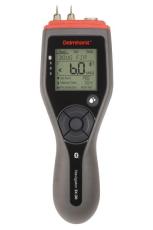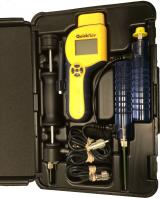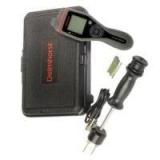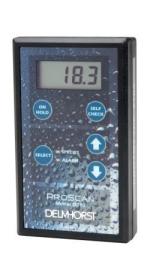
FAQs about moisture measurementBuilding inspection moisture meters - questions & answers |
|
Why Should I Use A Moisture Meter? Home Inspectors, Pest Control Operators and EIFS inspectors know that moisture intrusion is the single most important factor affecting the integrity of building structures. Delmhorst Instrument Company offers moisture meter packages specifically manufactured to meet the needs of inspectors. Proper use of a moisture meter allows the inspector to easily identify the source of moisture and to locate areas in the building that have been affected by moisture. How Does A Moisture Meter Work? There are two types of moisture meters typically used by the home inspector. Pin-type meters, which utilize the principle of electrical resistance, use wood or other hygroscopic materials as an element in a circuit by driving two pins or electrodes into it. Pinless meters use radio frequency signals to penetrate the material being tested. There is no pin intrusion into the surface of the material you are checking. Can I use a moisture meter to check for pest infestation? Yes -- a few meter readings in key locations of the structure will quickly indicate if the areas are safe or in danger of infestation. We recommend using pin-type meters for pest control applications as the best way to identify the exact point of infestation behind walls and ceilings. The key to finding hidden moisture is to use an electrode with insulated contact pins. These pins read only at their un-insulated pin tips, allowing the contractor to drive the pins into material at different depths, noting readings at each level of penetration. A pinless meter is a good way to identify infested areas, as long as you do not have to penetrate into a hidden material. At what level of moisture does infestation or decay occur? Wood technologists and pest control experts agree that most fungi need at least 20% MC. Readings higher then 20% is susceptible to mold growth and decay. Readings in the 17%-20% are borderline and normally require further testing. On the other hand infestation can occur at much lower levels, especially in humid conditions. Old House Borer and Powderpost Beetles can attack wood that falls in the 12-13% range. Which type of moisture meter works best for EIFS? To quickly identify wet areas, a pinless meter is easy to use. Pinless meters offer the convenience of testing a large area quickly, and help you determine if further testing is required in certain spots. Pinless meters read moisture closest to the source of the magnetic field, in this case, at the surface. Most pin-less meters read at a depth from 1/2" to 1". Moisture that resides in the substrate or insulation may go undetected without using a deep penetrating electrode. It is also important to remember that any metal or other conductive material behind the EIFS may give false readings. A pin type meter, on the other hand, is the best way to identify the exact location of moisture in the substrate and framing. A pin-type uses two pins that penetrate into the building at the users desired depth. When insulated contact pins are used, only the uncoated tips are exposed to the wood fiber, providing an accurate reading of moisture content at various levels of penetration. Pin-type meters are the only instruments that allow the inspector to identify exact location of moisture at a given point. Many EIFS inspectors use both types of meters. They can quickly identify problem areas using a pin-less meter, and also use a pin-type meter to identify exact location of moisture in the wood substrate. Where Does Most Moisture Intrusion Occur in EIFS Clad Houses? Most moisture intrusion occurs around windows, doors and any flashing. In many cases the moisture intrusion is directly related to poor installation practices. How Can I Find Moisture in the Substrate or Frame of the house. The most effective way to check for moisture in the substrate or frame is to us our 21-E electrode with 6" penetration pins. This method allows you to locate moisture behind the EIFS without it having to be torn away. How Do I Keep a Delmhorst Meter in Good Working Condition? Delmhorst moisture meters are well known for their ruggedness and ability to withstand years of rough handling. Like any testing instrument, a little care goes a long way toward trouble-free service:
If you have any further questions on using your moisture meter, please call us at +31 73 6395080 or fill out our Form under "Send us an email Top |
 |










